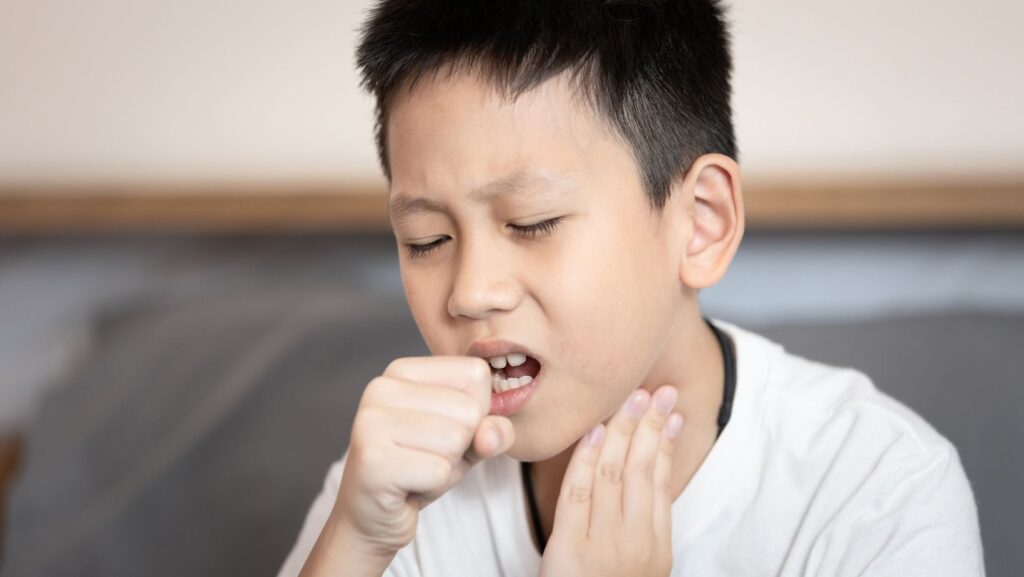
That nagging cough after a cold or the flu can stick around far longer than the fever or sore throat. In many cases, this is a post-infectious cough: your airways are still irritated and hypersensitive even though the infection has resolved.
Most people improve steadily over a few weeks; some need targeted help when thick mucus or airway reactivity won’t settle.
This guide maps what to expect week by week, what actually helps, when to escalate care, and where a portable mesh nebulizer – can fit into a clinician-guided plan.
How a Post-Infection Cough Works
- Irritated airways: The lining of your bronchial tubes becomes inflamed during infection. Afterward, the nerves stay jumpy for a while, so talking, laughing, cold air, or light exercise can trigger a cough.
- Mucus dynamics: Cilia (tiny hairs that move mucus) can be sluggish post-illness. If mucus is thick, you may cough more as your body tries to clear it.
- Not the same as being contagious: The cough can persist even when you’re no longer infectious; it’s the airway sensitivity that lingers.
- Typical duration: Many post-infection coughs improve within 3–8 weeks. If you aren’t trending better, check in with a clinician sooner.
Week-by-Week Roadmap
Week 1 (Days 1–7): The tail-end phase
What’s common: Coughing is still relatively frequent – often worse at night or on first waking. Energy is returning but not all the way.
What to do now:
- Prioritize sleep, gentle hydration, and short naps if needed.
- Use short-term cough relief at night if appropriate for you.
- Avoid smoke, perfumes, heavy cleaning fumes, and very cold air blasts. Why this matters: Rest and irritant control reduce airway “over-firing” so recovery begins sooner
Week 2 (Days 8–14): Irritable airways
What’s common: Cough bursts are shorter and less frequent but easier to trigger – phone calls, laughing, brisk walks, or a drafty room can set it off.
What to do now:
- Schedule voice breaks and pause during long conversations.
- Try gentle nasal rinses and warm showers to thin secretions.
- Keep indoor humidity balanced (roughly 40–50%—avoid damp or musty rooms).
- If nights are the worst, a brief bedtime suppressant may help you sleep.
Week 3 (Days 15–21): Subacute, still normal
What’s common: Many people feel clearly better. Others keep a “tickle” or occasional productive cough.
What to do now:
- Start graduated activity: easy walks, light mobility work, and steady, nose-first breathing.
- Track triggers for five days (cold air, long talking, stairs) and note whether things are trending better.
- Time to check in if: You aren’t improving at all, or breathlessness is out of proportion to activity.
Weeks 4 – 8: Home stretch – or time to escalate
What’s common: Most coughs fade significantly by weeks 4–6. Some persist up to 8 weeks.
What to do now:
- If you’re plateaued or the cough is disrupting sleep/work, book a non-urgent visit.
- Your clinician may consider possibilities like asthma-variant cough, upper airway cough syndrome (post-nasal drip), or reflux, and suggest targeted measures.
- Chronic threshold: At 8+ weeks, a cough is considered chronic and warrants a fuller work-up.
Week-by-Week Quick View
| Timeframe | What’s Typical | Best Next Actions |
| Week 1 | Frequent cough, worse at night/morning; energy returning slowly | Prioritize sleep and hydration; avoid irritants; consider short-term night suppressant if appropriate |
| Week 2 | Shorter, triggerable bursts (talking, cold air, exertion) | Voice breaks; gentle nasal care; keep humidity moderate; brief bedtime support if needed |
| Week 3 | Improving overall; lingering “tickle” or occasional mucus | Begin graded activity; log triggers; call if no trend toward better |
| Weeks 4–6 | Marked improvement for most | If plateaued or life-disruptive, schedule a review; discuss targeted options |
| Week 8+ | Chronic cough territory | Full evaluation recommended |
What Actually Helps
Daily habits. Prioritize sleep and pacing because tired, overworked airways stay irritable longer. A consistent bedtime, short daytime breaks, and easing back into normal activity give the cough reflex a chance to settle. If you notice a late-night or early-morning spike, shift stimulating tasks earlier and protect your sleep window.
Clean, balanced air. Your goal is “neutral air” rather than fragranced or overly dry/humid rooms. Dust regularly, open windows briefly when outdoor air is good, and avoid candles, incense, strong cleaners, and perfumes that can trigger coughing. If you use a humidifier, clean it well and aim for moderate humidity so you’re not creating a damp, musty environment.
Hydration strategy. Small, frequent sips keep mucus thinner and easier to clear than occasional large gulps. Warm fluids can soothe the throat and reduce the urge to cough, especially in the evening. Pair hydration with gentle movement—short walks or easy stretching—to encourage natural mucus clearance.
Gentle breathing drills. A few rounds of slow nasal inhales followed by longer, relaxed exhales help quiet a jumpy cough reflex. Keep shoulders soft, breathe low and quiet, and stop before you feel winded. Practiced a couple of times a day, these drills retrain the airway to react less to minor triggers like talking or cool air.
Over-the-counter options
Nighttime suppressant. Short-term use at bedtime can protect sleep when the cough keeps you awake. Better sleep reduces next-day throat irritation and the spiral of fatigue that makes coughing worse. Choose a simple single-ingredient product when possible and avoid stacking multiple sedating ingredients.

Expectorant. If your cough is productive but the mucus feels thick and sticky, an expectorant may help thin secretions so they clear with less coughing. It works best alongside good hydration and gentle activity. If you don’t notice benefit after a few days—or you feel worse—check in with a clinician rather than adding more medicines.
Use medicines wisely. Always read labels, match the product to your main symptom, and avoid “everything in one” combinations you don’t need. If you have chronic conditions, take prescription meds, are pregnant, or are selecting products for a child, ask a clinician or pharmacist first.
What usually doesn’t help
Antibiotics for an uncomplicated post-infection cough. Most lingering coughs after a cold or flu are driven by airway irritation, not an active bacterial infection. Unnecessary antibiotics won’t shorten recovery and can cause side effects or contribute to resistance. Reserve them for situations where a clinician identifies a likely bacterial cause.
Irritating “hacks.” Strong menthol blasts, scalding steam over boiling water, and inhaling non-medical substances can aggravate already sensitive airways or even injure them. If you use humidity, keep it gentle, clean, and moderate; if you use topical products, choose mild options and stop anything that stings or ramps up coughing. The aim is to calm the airway, not overwhelm it.
Solution Spotlight: Targeted Help When Mucus Won’t Budge
If thick, sticky mucus keeps you stuck after conservative steps, your clinician may recommend targeted airway therapy. A portable mesh nebulizer like TruNeb turns saline or prescribed medication into a fine mist that reaches the lower airways, helping loosen secretions and calm irritation.
Why people like this option:
- Portable and quiet: Easy to use at home, at work, or while traveling.
- Fast set-up: Simple assembly makes short sessions realistic, even on busy days.
- Modern mesh tech: Produces consistent, comfortable particle sizes for inhalation.
Use only as directed by your clinician, and keep parts clean and fully dry between uses
Red Flags – Seek Care
Seek urgent medical care if you’re working hard to breathe or breathing faster than usual. Go now if you notice new or worsening wheezing.
Do the same for chest pain or tightness, fainting, or dizziness. Get help if you cough up any blood – even small streaks.
A high fever (≥100.4°F / 38°C) or a fever that returns after you’ve started to recover also needs prompt attention.
Seek care if you become very dehydrated or confused, or if your lips or face look blue.
See a clinician if your cough isn’t improving after about three weeks, or if it lasts eight weeks or longer.
Infants and young children, adults over 65, anyone who is pregnant, people with weakened immune systems, and those with asthma, COPD, heart disease, or other chronic conditions should contact a clinician sooner and use a lower threshold for in-person evaluation.
Self-Check: Symptoms to Actions
| Situation | Likely Phase | What to Do Next |
| ~10 days since illness; cough clearly easing | Late acute → early post-infectious | Continue rest, hydration, irritant control |
| 3 weeks; still coughing, some sleep impact | Subacute post-infectious | Book a routine visit to review triggers and options |
| 5–6 weeks; little improvement or frequent night waking | Prolonged subacute | Ask about targeted measures (e.g., suitability of a portable mesh nebulizer) |
| Any week with red-flag symptoms | Potential complication | Seek urgent or same-day care |
| 8+ weeks of cough | Chronic cough | Arrange a full evaluation |
Telehealth Prep Checklist
- Symptom timeline: First day of illness, first day you felt “better,” and how the cough changed.
- Triggers and patterns: Cold air, talking, exercise, time of day, lying down vs. upright.
- Home environment: Humidity level, new products (cleaners, fragrances), smoke exposure.
- What you’ve tried: OTC meds, humidifier use, nasal rinses, breathing exercises, pacing.
- Goals and worries: Sleep disruption, work limitations, chest sensations, travel plans.
Quick FAQs
How long does a post-infection cough las
Many improve steadily over 3 – 8 weeks. If you’re not trending better, check in earlier – don’t wait for week eight if life is being significantly disrupted.
Can children have a long post-infection cough?
Yes. Kids often cough longer after viral illnesses because their airways are smaller and more easily irritated. Use kid-safe measures only and consult a pediatric clinician sooner for concerning or persistent symptoms.
Does exercise help or hurt?
Gentle, graded activity usually helps recovery as long as you pace and back off when cough or breathlessness spikes. Think “little and often,” not “all at once.”
Are humidifiers useful?
They can be, if you keep humidity moderate and the device clean. Over-humidifying or using a dirty unit can make things worse.
Should I take antibiotics?
Not for a typical post-infection cough without signs of bacterial illness. Your clinician will decide if antibiotics are warranted based on your exam and overall picture.
Bottom Line
A lingering cough after a respiratory bug is common and usually improves across several weeks as airway irritation settles. Protect your sleep, avoid irritants, hydrate, and build back activity gradually.
If thick mucus or airway sensitivity won’t budge, talk with your clinician about targeted options. This is where a portable mesh nebulizer can be a practical, travel-ready solution within a guided care plan. Seek prompt care for any red-flag symptoms or if your cough becomes chronic.
